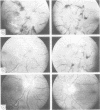Abstract
Five patients with serious ocular complications of benign intracranial hypertension are described. Optic nerve sheath fenestration resulted in resolution of papilloedema with, in three instances, improvement in vision. Benign intracranial hypertension may not always be benign for vision and fenestration operations may prevent or reverse visual deterioration by an effect on the optic nerve rather than by reducing intra-cranial pressure.
Full text
PDF
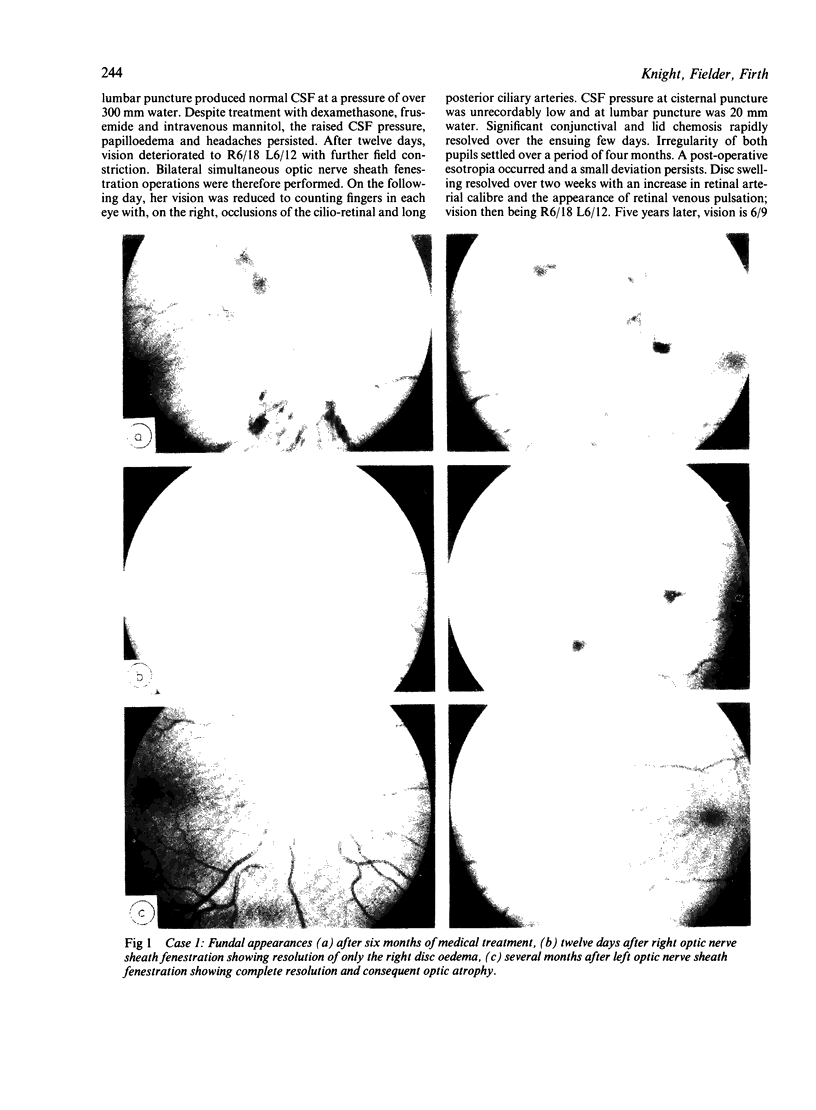
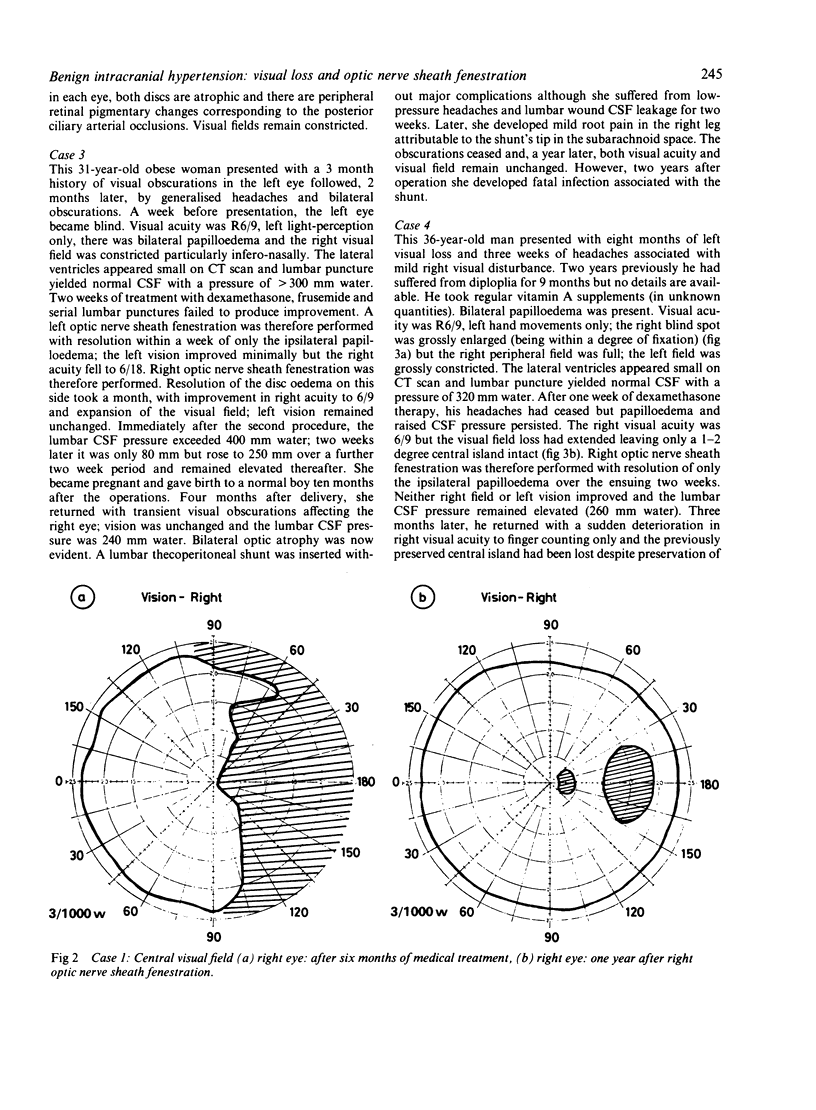
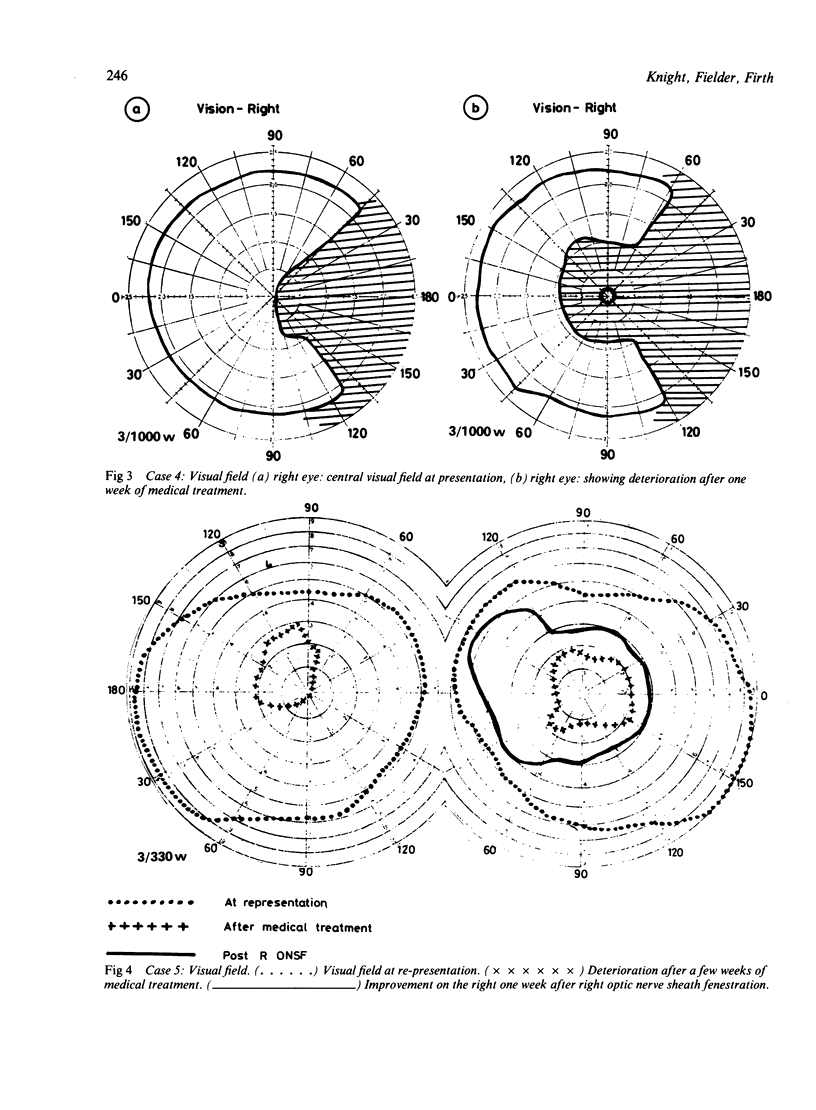

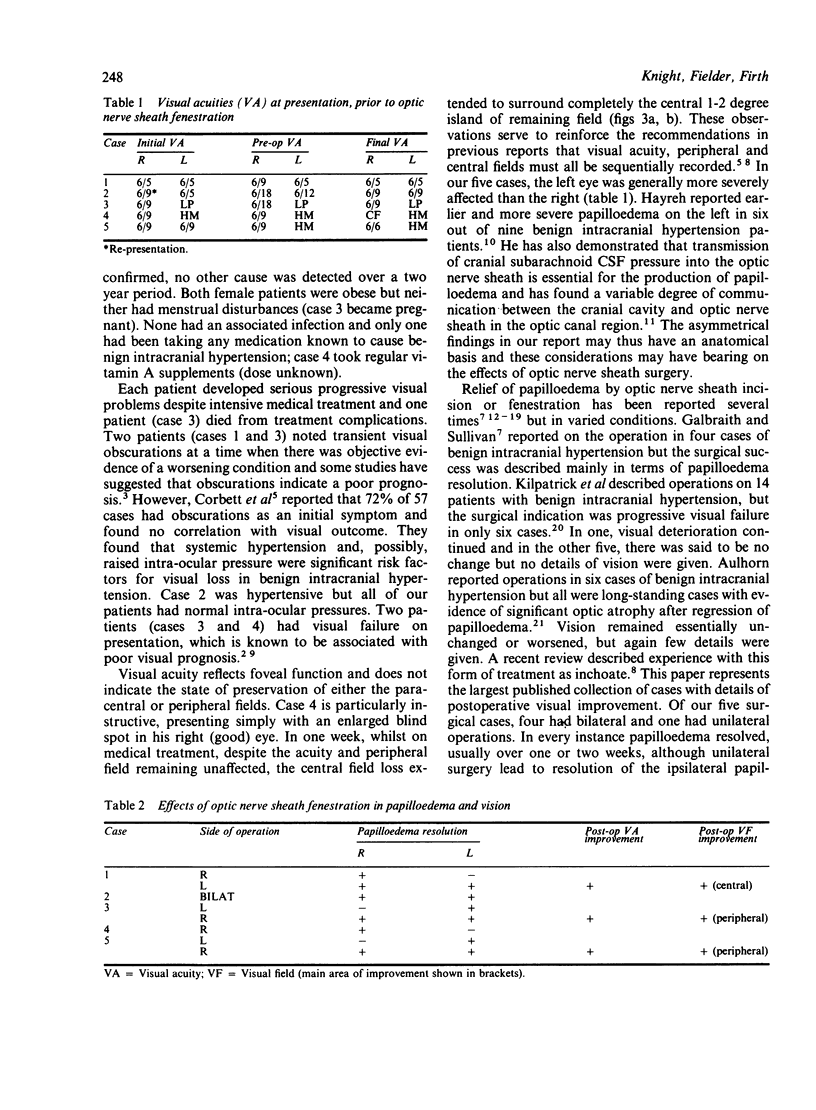
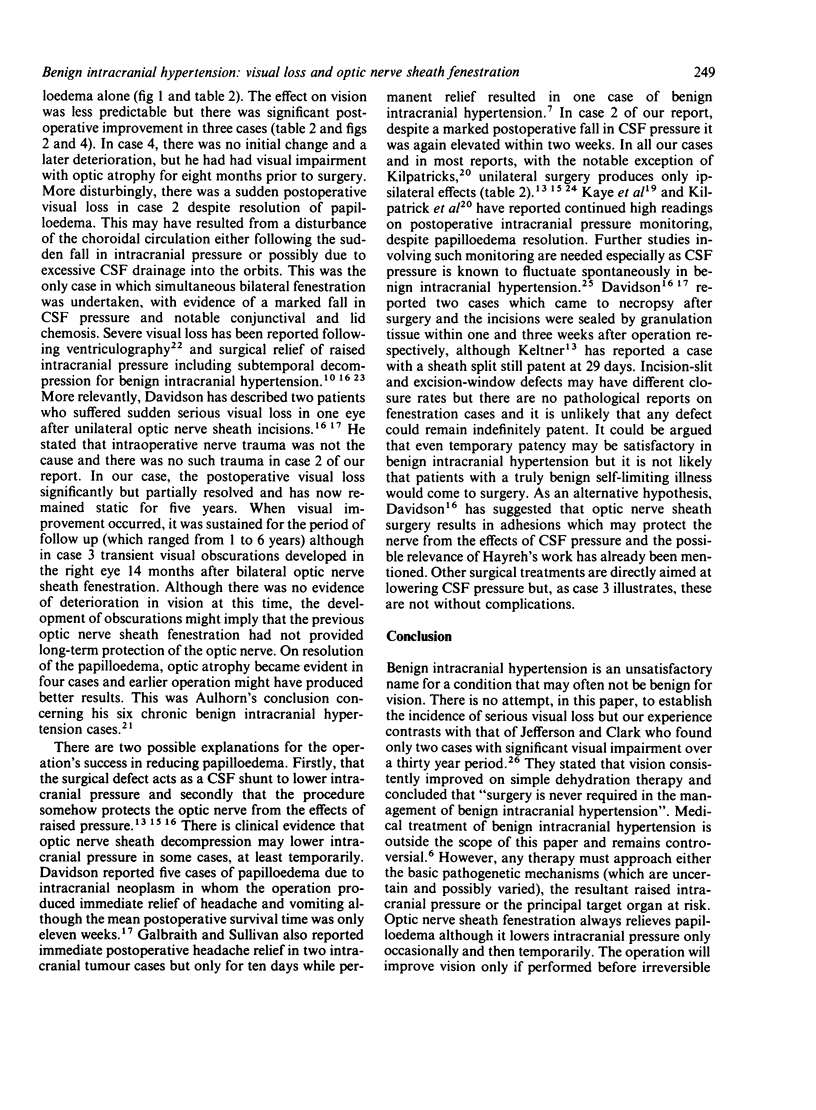
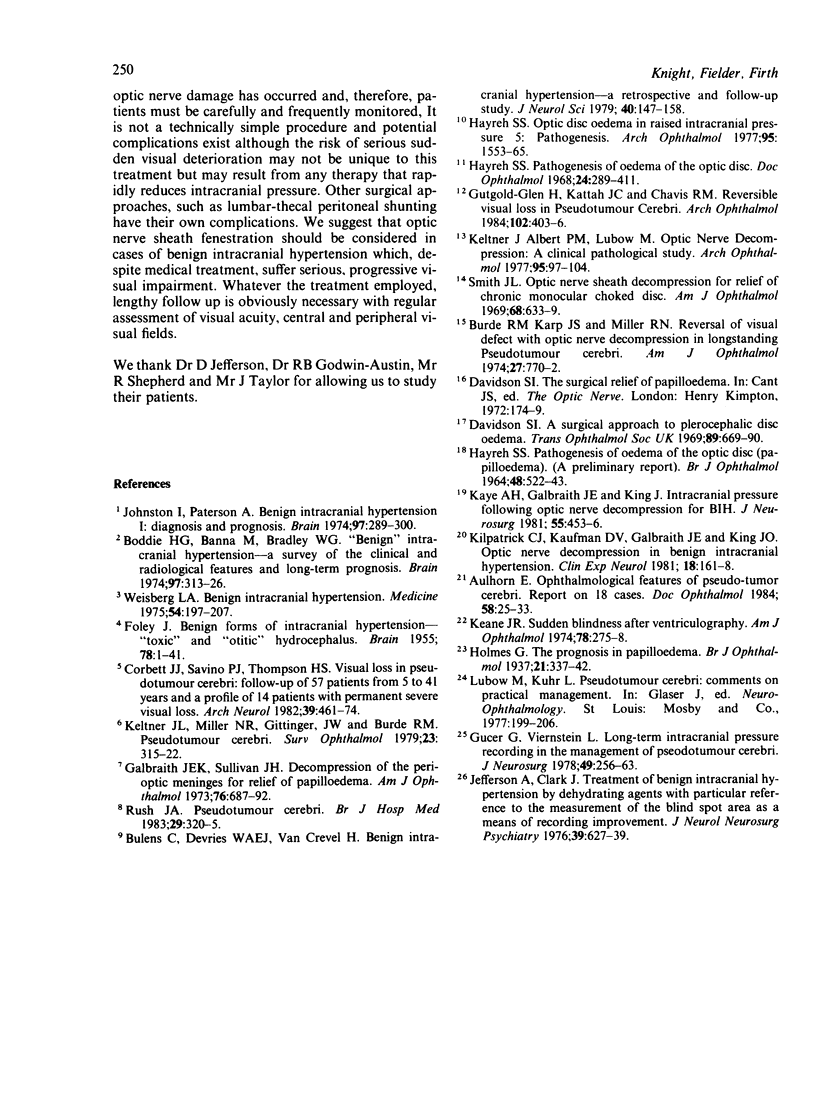
Images in this article
Selected References
These references are in PubMed. This may not be the complete list of references from this article.
- Aulhorn E. Ophthalmological features of pseudo-tumor cerebri. Report on 18 cases. Doc Ophthalmol. 1984 Aug 15;58(1):25–33. doi: 10.1007/BF00140895. [DOI] [PubMed] [Google Scholar]
- Boddie H. G., Banna M., Bradley W. G. "Benign" intracranial hypertension. A survey of the clinical and radiological features, and long-term prognosis. Brain. 1974 Jun;97(2):313–326. doi: 10.1093/brain/97.1.313. [DOI] [PubMed] [Google Scholar]
- Bulens C., De Vries W. A., Van Crevel H. Benign intracranial hypertension. A retrospective and follow-up study. J Neurol Sci. 1979 Feb;40(2-3):147–157. doi: 10.1016/0022-510x(79)90200-4. [DOI] [PubMed] [Google Scholar]
- Burde R. M., Karp J. S., Miller R. N. Letter: Reversal of visual deficit with optic nerve decompression in long-standing pseudotumor cerebri. Am J Ophthalmol. 1974 May;77(5):770–772. doi: 10.1016/0002-9394(74)90555-8. [DOI] [PubMed] [Google Scholar]
- Corbett J. J., Savino P. J., Thompson H. S., Kansu T., Schatz N. J., Orr L. S., Hopson D. Visual loss in pseudotumor cerebri. Follow-up of 57 patients from five to 41 years and a profile of 14 patients with permanent severe visual loss. Arch Neurol. 1982 Aug;39(8):461–474. doi: 10.1001/archneur.1982.00510200003001. [DOI] [PubMed] [Google Scholar]
- Davidson S. I. A surgical approach to plerocephalic disc oedema. Trans Ophthalmol Soc U K. 1970;89:669–690. [PubMed] [Google Scholar]
- FOLEY J. Benign forms of intracranial hypertension; toxic and otitic hydrocephalus. Brain. 1955;78(1):1–41. doi: 10.1093/brain/78.1.1. [DOI] [PubMed] [Google Scholar]
- Galbraith J. E., Sullivan J. H. Decompression of the perioptic meninges for relief of papilledema. Am J Ophthalmol. 1973 Nov;76(5):687–692. doi: 10.1016/0002-9394(73)90564-3. [DOI] [PubMed] [Google Scholar]
- Gutgold-Glen H., Kattah J. C., Chavis R. M. Reversible visual loss in pseudotumor cerebri. Arch Ophthalmol. 1984 Mar;102(3):403–406. doi: 10.1001/archopht.1984.01040030321028. [DOI] [PubMed] [Google Scholar]
- Gücer G., Viernstein L. Long-term intracranial pressure recording in the management of pseudotumor cerebri. J Neurosurg. 1978 Aug;49(2):256–263. doi: 10.3171/jns.1978.49.2.0256. [DOI] [PubMed] [Google Scholar]
- HAYREH S. S. PATHOGENESIS OF OEDEMA OF THE OPTIC DISC (PAPILLOEDEMA). A PRELIMINARY REPORT. Br J Ophthalmol. 1964 Oct;48:522–543. doi: 10.1136/bjo.48.10.522. [DOI] [PMC free article] [PubMed] [Google Scholar]
- Hayreh S. S. Pathogenesis of oedema of the optic disc. Doc Ophthalmol. 1968;24(2):289–411. doi: 10.1007/BF02550944. [DOI] [PubMed] [Google Scholar]
- Holmes G. THE PROGNOSIS IN PAPILLOEDEMA. Br J Ophthalmol. 1937 Jul;21(7):337–342. doi: 10.1136/bjo.21.7.337. [DOI] [PMC free article] [PubMed] [Google Scholar]
- Jefferson A., Clark J. Treatment of benign intracranial hypertension by dehydrating agents with particular reference to the measurement of the blind spot area as a means of recording improvement. J Neurol Neurosurg Psychiatry. 1976 Jul;39(7):627–639. doi: 10.1136/jnnp.39.7.627. [DOI] [PMC free article] [PubMed] [Google Scholar]
- Johnston I., Paterson A. Benign intracranial hypertension. I. Diagnosis and prognosis. Brain. 1974 Jun;97(2):289–300. doi: 10.1093/brain/97.1.289. [DOI] [PubMed] [Google Scholar]
- Kaye A. H., Galbraith J. E., King J. Intracranial pressure following optic nerve decompression for benign intracranial hypertension. Case report. J Neurosurg. 1981 Sep;55(3):453–456. doi: 10.3171/jns.1981.55.3.0453. [DOI] [PubMed] [Google Scholar]
- Keane J. R. Sudden blindness after ventriculography. Bilateral retinal vascular occlusion superimposed on papilledema. Am J Ophthalmol. 1974 Aug;78(2):275–278. doi: 10.1016/0002-9394(74)90089-0. [DOI] [PubMed] [Google Scholar]
- Keltner J. L., Albert D. M., Lubow M., Fritsch E., Davey L. M. Optic nerve decompression. A clinical pathologic study. Arch Ophthalmol. 1977 Jan;95(1):97–104. doi: 10.1001/archopht.1977.04450010097009. [DOI] [PubMed] [Google Scholar]
- Keltner J. L., Miller N. R., Gittinger J. W., Burde R. M. Pseudotumor cerebri. Surv Ophthalmol. 1979 Mar-Apr;23(5):315–322. doi: 10.1016/0039-6257(79)90161-9. [DOI] [PubMed] [Google Scholar]
- Kilpatrick C. J., Kaufman D. V., Galbraith J. E., King J. O. Optic nerve decompression in benign intracranial hypertension. Clin Exp Neurol. 1981;18:161–168. [PubMed] [Google Scholar]
- Rush J. A. Pseudo problems pseudotumour cerebri. Br J Hosp Med. 1983 Apr;29(4):320–325. [PubMed] [Google Scholar]
- Weisberg L. A. Benign intracranial hypertension. Medicine (Baltimore) 1975 May;54(3):197–207. doi: 10.1097/00005792-197505000-00002. [DOI] [PubMed] [Google Scholar]



